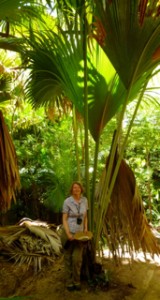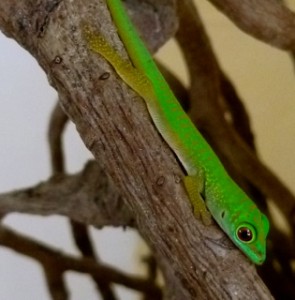
This young Coco de Mer towers over me, producing petioles that allow the leaves to reach up to the canopy
Here be giants
The Vallee de Mai is one of two World Heritage Sites managed by the Seychelles Islands Foundation. It’s a unique place, home to six different endemic palm species, including the legendary Coco de Mer. There’s nothing ordinary about this plant: it produces the world’s heaviest seeds, and its leaves are among the world’s largest. One of the most extraordinary experiences of visiting the Vallee de Mai is to get caught in a rainstorm when inside the park. The Coco de Mer leaves are so good at intercepting and funneling water that you will remain dry despite the rain hammering on the canopy above. This aspect of the plant’s biology is the focus of fascinating work currently undertaken by Chris Kaiser-Bunbury and Peter Edwards.
A paradise for lizard-lovers
Not only is the Vallee home to unique palms, but to a range of wonderful lizards. Marc Jean-Baptiste,manager of the Vallee and superintendent of research, points out several jeweled Phelsuma geckos as well as the bronze-eyed geckos – available in three sizes – including the magnificent trachygaster. Marc also reveals that there are two tiny chameleons in the park: “if you come in at night and shine your torch, you can find them hanging from the fronds of the Coco de Mer, but you just have to be lucky to see them in the daytime”. Sadly, we don’t have that luck, but we are far from disappointed with the lizards we see, including a close encounter with a trachygaster that has come down from the canopy to lap pollen from a male Coco-de-Mer flower.
Research
SIF not only manage the site, but carry out active research on many of its inhabitants. Yet another endemic species is the Seychelles black parrot. This wonderful bird with its whistling call can be much easier to hear than see as it dashes through the forest. At the AGM, Nancy Bunbury explains how her team have learned that each female has its own unique call, and that females can sometimes solicit the help of more than one male to feed her and help raise her chicks. 2012-2013 has been a very good breeding season for the parrots, although introduced rats are a definite concern. Nancy also reported on fascinating work carried out by Chris Kaiser-Bunbury on the pollination of the Coco-de-Mer. It’s clearly something that arouses strong passions and their rigorous scientific approach will finally provide clear answers.
SIF showed that their integrated program of conservation and research can deliver better understanding, as well as ultimately providing better management. If you don’t study populations and identify the threats, then you can’t act to reduce them.

